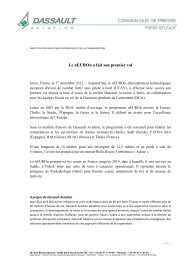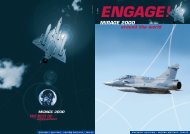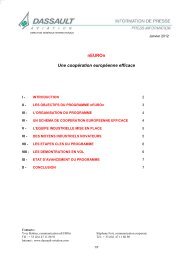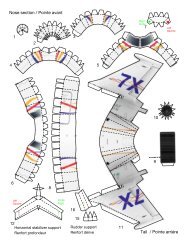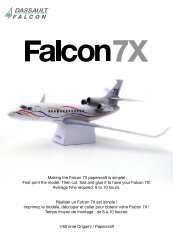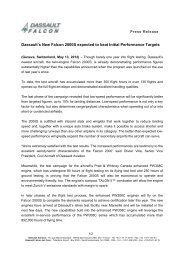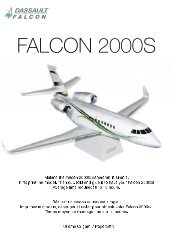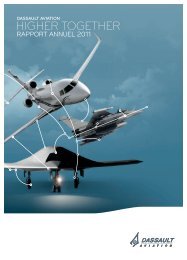Fox Three n°14 - application/pdf - Dassault Aviation
Fox Three n°14 - application/pdf - Dassault Aviation
Fox Three n°14 - application/pdf - Dassault Aviation
Create successful ePaper yourself
Turn your PDF publications into a flip-book with our unique Google optimized e-Paper software.
D a s s a u l t A v i a t i o n • S n e c m a • T h a l e s<br />
INDEPENDENCE<br />
- Photo F. Robineau - <strong>Dassault</strong> <strong>Aviation</strong><br />
When a single country makes your aircraft from nose to tail, you know exactly what<br />
you’re getting into. Rafale is not subject to multinational controls. It also offers<br />
unrestricted access to key weapon systems technologies, spare parts, and know-how.<br />
Rafale offers superior operational effectiveness and failsafe worldwide support, yet isn’t<br />
delivered wrapped in red tape. Or with strings attached. Rafale. The OMNIROLE fighter
D a s s a u l t A v i a t i o n • S n e c m a • T h a l e s<br />
Editorial<br />
The Rafale programme is rapidly moving<br />
forward with new variants of the avionics<br />
and of the M88-2 engine being introduced<br />
to satisfy the most stringent requirements.<br />
At the same time, the range of weapons<br />
and of external targeting and reconnaissance<br />
pods the omnirole fighter can carry is being<br />
considerably expanded. <strong>Dassault</strong>, Snecma<br />
OMNIROLE<br />
and Thales are always keen to develop<br />
close ties with the customer, and acquiring<br />
the Rafale is a strong commitment towards<br />
autonomy and independence.<br />
Enjoy!<br />
Summary<br />
p.4/9<br />
p.10/15<br />
p.16/19<br />
Rafale carries out different complex combat assignments simultaneously. This makes it<br />
different from so-called “multirole” or “swing-role” aircraft. Higher systems integration, advanced<br />
data fusion, and inherent low observability all make Rafale the first true omnirole fighter.<br />
Able to fight how you want, when you want, where you want. Rafale. The OMNIROLE fighter<br />
M88: more thrust<br />
than enough<br />
Nowhere to hide<br />
Global reach<br />
Photos : DASSAULT AVIATION - S. RANDÉ, V. ALMANSA, A. PARINGAUX, F. ROBINEAU, K. TOKUNAGA, H.P. GROLLEAU / SIRPA AIR - A. JEULAND / Snecma - Eric Drouin<br />
THALES / Airbus Military. Print: Imprimerie Moutot 2009. This document is not contractual and cannot engage the responsability of the industrial partners in any matter. <strong>Dassault</strong> <strong>Aviation</strong><br />
and the industrial partners reserve the right to modify any here in indicated characteristics without prior notice.
M88: MORE THRUST THAN ENOUGH<br />
Snecma (a SAFRAN Group company) is currently working on a more powerful variant<br />
of the acclaimed M88-2 turbofan, a state-of-the-art engine which powers the Rafale<br />
omnirole fighter.<br />
The Rafale was conceived as a swing-role fighter capable<br />
of carrying out an extremely wide range of missions. As a<br />
result, the M88 engine had to comply with stringent requirements:<br />
it had to be compact and was designed to excel at<br />
low and high levels. Moreover, engine response to pilot throttle<br />
movements had to be instantaneous. “The M88 is an innovative<br />
powerplant with a very high thrust to weight ratio,<br />
an extremely low fuel consumption in all flight regimes,<br />
and a very long life, explains Michel Caunes, Snecma<br />
M88 programme Director. As of October 2009, 75 production<br />
Rafales powered by M88 engines had been delivered and<br />
development and production engines had logged more<br />
than 100,000 functioning hours.”<br />
High level of<br />
performance<br />
To provide the required amount<br />
of thrust while keeping fuel<br />
consumption within given limits,<br />
Snecma engineers had to come<br />
up with innovative solutions to<br />
ensure that performance levels<br />
complied with the extremely<br />
demanding French power and<br />
durability requirements.<br />
Consequently, the M88-2<br />
incorporates advanced<br />
technologies such as integrallybladed<br />
compressor disks,<br />
called ‘blisks’, low-pollution<br />
combustor, single-crystal<br />
high-pressure turbine blades,<br />
ceramic coatings, revolutionary<br />
powder metallurgy disks, and<br />
composite materials.<br />
Additionally, the M88 has been<br />
optimised so that its small<br />
infrared signature does not<br />
compromise the Rafale’s overall<br />
IR signature, and its non-polluting,<br />
smoke-free emissions<br />
make the aircraft more difficult<br />
to detect visually than older<br />
designs.<br />
The M88-2 powerplant is rated<br />
at 10,971 lb dry and 16,620<br />
lb with afterburner. It is equipped<br />
with a fully-redundant Snecma<br />
FADEC (Full Authority Digital<br />
Engine Control) which allows<br />
it to accelerate from idle to full<br />
afterburner in less than three<br />
seconds. Thanks to the FADEC,<br />
the M88-2 engines give the<br />
Rafale stunning performance:<br />
carefree engine handling allows<br />
the throttle to be slammed from<br />
combat power to idle and back<br />
to combat power again<br />
anywhere in the flight<br />
envelope. The compressor<br />
utilises a three stage low<br />
pressure fan, and a six stage<br />
high pressure compressor. Peak<br />
engine temperature is 1,850 K<br />
(1,577 °C) with a pressure<br />
ratio of 24.5:1, and, at maximum<br />
dry power, specific fuel<br />
consumption is in the order of<br />
0.8 kg/daN.h, increasing to<br />
1.7 kg/daN.h with afterburner.<br />
Modular engine<br />
Reducing the costs of ownership<br />
and improving performance<br />
have always been<br />
obvious targets for Snecma<br />
and the M88 has been<br />
designed to achieve the<br />
optimum combination of operational<br />
readiness and reliability.<br />
To facilitate rapid repair<br />
and maintenance in harsh conditions<br />
and minimise spares<br />
holdings, the engine is divided<br />
into 21 modules, interchangeable<br />
without a need<br />
for balancing and re-calibration.<br />
Some of these modules<br />
can even be changed without<br />
taking the engine out of the<br />
Rafale airframe, and a M88<br />
can be removed and replaced<br />
in under an hour. Even more significant<br />
is the fact that, after<br />
maintenance, there is no need<br />
to check the turbofan in a test<br />
bench before it is installed<br />
back on the aircraft. The M88<br />
is the only engine of its kind<br />
that can be returned to service<br />
after changing modules without<br />
requiring a new ground acceptance<br />
test – all what it needs is<br />
a simple leak test. As a direct<br />
consequence, the French Air<br />
Force has decided not to procure<br />
any dedicated test bench<br />
for the M88. Since entering<br />
service, the M88-2 has undergone<br />
a number of improvements<br />
and M88-2 Stage 4<br />
engines are currently being<br />
delivered.<br />
4 FOXTHREE<br />
FOXTHREE 5
M88: MORE THRUST THAN ENOUGH<br />
M88 ECO and TCO<br />
technology programs<br />
The M88 was designed as a<br />
totally modular engine with a<br />
lot of built-in growth potential.<br />
In the last couple of years,<br />
Snecma has been extremely<br />
active, testing new hardware<br />
to increase engine life, reduce<br />
costs and demonstrate that<br />
higher thrust levels could be<br />
achieved.<br />
From 2003 to 2007, during<br />
the M88 ECO programme,<br />
Snecma engineers tested new<br />
technologies to demonstrate<br />
that they could increase even<br />
further the life of some components<br />
to diminish operating<br />
costs. In all, more than 4,000<br />
Total Accumulated Cycles<br />
(TACs) were logged by the test<br />
engine during endurance trials.<br />
The engine was also rated up<br />
to 20,000 pounds of thrust to<br />
demonstrate that this level of<br />
power could be achieved with<br />
a limited amount of modifications.<br />
Launched in 2008, the M88<br />
TCO (Total Cost of Ownership)<br />
programme was initiated to<br />
further improve engine durability<br />
and bring support costs<br />
down. Capitalising on the ECO<br />
project, Snecma was able to<br />
upgrade the high-pressure<br />
compressor and the high-pressure<br />
turbine of the M88-2:<br />
cooling is ameliorated and<br />
stronger components have<br />
been introduced, boosting<br />
durability by up to 50%. Life<br />
expectancy between overhaul<br />
has been considerably<br />
expanded for a number of<br />
modules, helping further minimise<br />
the impact of planned<br />
maintenance on engine availability.<br />
The First Engine To Test<br />
(FETT) ran for the first time in<br />
September 2009 and the first<br />
TCO pack for M88 engines<br />
will be delivered to the French<br />
Armed Forces in 2011.<br />
Uprated engine<br />
For Air Arms requiring more<br />
power for enhanced combat<br />
agility and improved performance<br />
in very hot weather,<br />
Snecma is considering the<br />
development of a variant of<br />
the M88 which will be rated at<br />
20,000 lb with afterburner.<br />
The staged approach has had<br />
a very good impact on<br />
commonality between variants:<br />
“since the M88 programme<br />
was launched, one of our<br />
objectives was to regularly<br />
introduce new technologies<br />
that could reduce the engine’s<br />
operating costs, increase its<br />
dispatch reliability and increase<br />
its thrust, explains Michel<br />
Caunes. The successive M88<br />
ECO and TCO technology<br />
programs allow us to progressively<br />
reduce risks and<br />
limit associated costs. We have<br />
managed to retain a very high<br />
degree of commonality<br />
between the M88-2 TCO and<br />
the uprated engine. Compared<br />
with the M88-2 TCO, the<br />
uprated turbofan will require<br />
less than 20% new parts,<br />
including a redesigned lowpressure<br />
compressor for a<br />
higher airflow. In fact, we will<br />
have to alter only two of the<br />
21 modules. This is quite an<br />
achievement which will enable<br />
us to keep costs within<br />
acceptable limits. The M88-2<br />
and the new engine will remain<br />
fully interchangeable, but the<br />
introduction of the new type<br />
will impose the adoption of<br />
slightly enlarged air-intakes<br />
to allow for the higher airflow.”<br />
With the new uprated engine,<br />
the Rafale omnirole fighter will<br />
prove even more competitive<br />
in terms of thrust-to-weight ratio<br />
at combat weight. The fighter<br />
will be able to take off at<br />
maximum weight in a very<br />
short distance, even in the most<br />
demanding weather conditions,<br />
at high altitude, in the<br />
heat of the desert. Climb rate,<br />
acceleration, sustained turn<br />
rate will all be massively<br />
improved, bringing the Rafale’s<br />
combat effectiveness to<br />
unprecedented levels.<br />
6 FOXTHREE<br />
FOXTHREE 7
8 FOXTHREE FOXTHREE 9
NOWHERE TO HIDE<br />
For the Rafale omnirole fighter, Thales has<br />
provided the most advanced sensors and<br />
integrated avionics suite ever designed for<br />
a combat aircraft. It comprises the RBE2<br />
electronic scanning radar, the Front Sector<br />
Optronics, the Spectra electronic warfare<br />
suite, the Damocles targeting pod and<br />
the AREOS (1) reconnaissance system,<br />
all supplied by Thales.<br />
All the Rafale’s sensors are closely integrated and all data<br />
is automatically fused to massively reduce pilot workload and<br />
significantly increase tactical effectiveness. “Our goal was<br />
to avoid saturating the pilot, explains Jean-Noël Stock,<br />
Thales Rafale Programme Director. This smart data fusion significantly<br />
increases mission success rates through enhanced<br />
crew awareness and improved aircraft survivability. This is<br />
a crucial advantage over our competitors.”<br />
AESA (2)<br />
MULTI-SENSOR<br />
DATA FUSION<br />
considerably more than 50% and the radar can look in many<br />
directions at the same time, offering significantly enhanced<br />
tracking capabilities. Angular coverage in azimuth is improved<br />
and very small targets with lower radar cross section such as<br />
cruise missiles could also be detected. Furthermore, AESA<br />
radars are inherently more reliable and cheaper to maintain.”<br />
The AESA demonstrator first flew in 2002 and, since then,<br />
hundreds of flight hours have been logged to support the<br />
development effort. On top of that, the AESA has been successfully<br />
evaluated by a number of potential customers. A<br />
European production line for T/R modules has been set up<br />
and, at the time of writing, six development AESAs had been<br />
delivered and three pre-series AESAs were in production, with<br />
first deliveries to <strong>Dassault</strong> <strong>Aviation</strong> planned for 2011.<br />
Passive interception<br />
The Rafale is the only fighter equipped with an integrated<br />
system optimised for target identification and battle damage<br />
assessment at stand-off distances. The Front Sector Optronics<br />
is composed of a powerful TV sensor to identify targets and<br />
to determine the number of hostile aircraft within an incoming<br />
raid, and of an eyesafe laser rangefinder for telemetry.<br />
When used in conjunction with the long range Mica IR missile,<br />
the FSO allows entirely passive interceptions to be carried<br />
out without radar emissions. In the air-to-ground mode,<br />
the FSO is used to accurately determine target coordinates<br />
before attacking with precision weapons such as the AASM<br />
(Air-to-Surface Modular Armament) or LGBs (Laser Guided<br />
Bombs). A new generation infrared sensor for passive search<br />
and track of airborne targets and for night identification<br />
could be integrated into the FSO at a later stage. Such an<br />
infrared sensor operating in the 8 to 12 µm band has been<br />
fielded in the French Air Force F2 Standard Rafales, and an<br />
updated variant working in the 3 to 5 µm band is being<br />
studied for the future growth of the FSO. The FSO has been<br />
in service since 2005 and is now combat proven.<br />
From the outset, the French Armed Forces have adopted an<br />
innovative electronic scanning radar for the Rafale fighter.<br />
Electronic scanning radars have numerous advantages<br />
over legacy mechanically steered types: they scan the sky<br />
much more quickly, they allow targets to be tracked outside<br />
the selected search volume and their radar modes can be<br />
interleaved.<br />
The first Rafales were all fitted with a passive antenna and<br />
Thales and the French Military are now switching to active<br />
electronic scanning array technology. “In the late nineties,<br />
we thought there were some risks involved going straight<br />
to the AESA and this is why we chose the PESA (3) for the<br />
first Rafale standards, stresses Jean-Noël Stock. The active<br />
array is made up of solid-state GaAs transmit/receive<br />
modules which can steer and reposition the radar beam at<br />
very high speed in any direction. The new radar variant also<br />
incorporates a new data processing unit and a strengthened<br />
structure to cope with the higher weight of the AESA.<br />
In terms of performance, detection range is increased by<br />
10 FOXTHREE<br />
FOXTHREE 11
NOWHERE TO HIDE<br />
SPECTRA<br />
Damocles<br />
The Spectra (4) multi-spectral, totally integrated electronic<br />
warfare suite is designed to ensure efficient electromagnetic<br />
detection, laser warning, missile approach warning<br />
using passive IR detection technology, jamming and<br />
chaff/flare dispensing. <strong>Three</strong>-dimension direction-finding<br />
accuracy is excellent, and the time taken for signal identification<br />
is extremely short. Its very high processing power<br />
gives outstanding detection and omni-directional jamming<br />
performance through active antennas, optimising the<br />
response to match the threat, even in a multi-threat environment.<br />
The location and types of systems detected by Spectra can<br />
be recorded for later analysis, giving Rafale operators a<br />
substantial built-in ELINT capability.<br />
In modern warfare, the ability to detect, localise, identify<br />
and engage ground targets at stand-off distances is a real<br />
necessity. This is why the Rafale is now being fitted with the<br />
Thales Damocles targeting pod. The new infrared (3rd<br />
generation staring array detector) and laser technologies<br />
chosen for the Damocles provide extended detection and<br />
recognition ranges, permitting laser-guided armament to<br />
be delivered at substantially greater ranges from higher altitudes,<br />
considerably reducing the aircraft’s vulnerability to<br />
short/medium-range air-defence systems.<br />
In mid-2009, the French MoD issued a contract for the<br />
Mastrid (Multi-context Airborne System for Target Recognition<br />
and IDentification) demonstrator to ensure that new capabilities<br />
will be available for the Damocles XF (eXtended<br />
Features) from 2012. With the Mastrid project, a new highdefinition<br />
TV sensor optimised for short-range engagement<br />
and a new software to boost the resolution of the IR sensor<br />
will be developed and test flown.<br />
AREOS<br />
For both strategic and tactical reconnaissance missions, the<br />
French Armed Forces have adopted the Thales System Reco<br />
NG (new generation tactical reconnaissance system) for the<br />
Rafale. “This high-tech, day and night equipment can be<br />
used in a wide range of scenarios, from stand-off distances<br />
at very high altitude down to very high speed and extremely<br />
low-level, enthuses Jean-Noël Stock. To shorten the<br />
intelligence gathering cycle and accelerate the tempo of<br />
operation, the pod is fitted with a datalink which allows high<br />
resolution images to be transmitted back to the military<br />
deciders in real time.” Since July 2009, the System Reco<br />
NG has been undergoing qualification testing / operational<br />
evaluation at Mont-de-Marsan Air Base, with entry into service<br />
planned for early 2010. This very advanced system is now offered<br />
on the export market under the AREOS designation.<br />
(1)<br />
AREOS: Airborne REconnaissance and Observation System<br />
(2)<br />
AESA: Active Electronically Scanned Array Radar<br />
(3)<br />
PESA: Passive Electronically Scanned Array Radar<br />
(4)<br />
SPECTRA: Self-Protection Equipment Countering Threats of Rafale Aircraft<br />
With such a large suite of advanced sensors and a direct<br />
access to datalink networks, the Rafale is a key contributor<br />
to the common tactical air picture. The ongoing improvements<br />
to its sensor suite will further increase the combat<br />
effectiveness of an already revolutionary aircraft<br />
12 FOXTHREE<br />
FOXTHREE 13
14 FOXTHREE<br />
FOXTHREE 15
GLOBAL REACH<br />
With its outstanding endurance, its in-flight refuelling capability and<br />
its very long-range stand-off weapons, the Rafale omnirole fighter is<br />
extremely well equipped to strike distant, well-defended, deeply buried<br />
hardened targets.<br />
The Rafale has been designed as a very compact, high-tech fighter capable of carrying a huge<br />
external load of fuel tanks and missiles. In fact, it can carry more than 15,000 kg of kerosene<br />
and weapons, quite an accomplishmentor an aircraft weighing less than 10 tonnes empty.<br />
Scalp<br />
For long-range attacks of highvalue,<br />
heavily defended targets,<br />
the French Armed Forces<br />
have selected the Scalp cruise<br />
missile of the MBDA Scalp /<br />
Apache / Storm Shadow /<br />
Black Shaheen family. The<br />
Rafale’s normal combat load<br />
is composed of two Scalps,<br />
four Mica air-to-air missiles<br />
and three 2,000-litre drop<br />
tanks. The Scalp can be<br />
released at very low level,<br />
with the Rafale flying in<br />
terrain-following mode to avoid<br />
detection. With its fuel-efficient<br />
Microturbo engine, this<br />
‘intelligent’, stealth weapon<br />
can navigate autonomously<br />
at high subsonic speed towards<br />
the target which will be clearly<br />
identified by its onboard<br />
infrared sensor: automatic<br />
target recognition algorithms<br />
compare the actual scene with<br />
the memorised scene, identify<br />
the designated target, and<br />
accurately select the impact<br />
point in order to hit with very<br />
high precision. To maximise<br />
its military effect, the Scalp is<br />
fitted with a remarkably<br />
powerful Broach tandem<br />
warhead which can defeat<br />
heavily protected bunkers.<br />
Buddy-buddy tankers<br />
With their 4,700 kg of internal<br />
fuel, single-seat Rafales boast<br />
an impressive range which can<br />
be massively extended by up<br />
to five external drop tanks (three<br />
2,000-litre and two 1,250-litre<br />
fuel tanks) under five wet<br />
hardpoints, four under the<br />
wings and one under the fuselage.<br />
Range can be further<br />
increased thanks to air-to-air<br />
refuelling and the Rafale can<br />
refuel from a wide range of<br />
tankers: A330 MRTT, Boeing<br />
707, Il-78 Midas, KC-135,<br />
KC-130, VC-10… It can also be<br />
fitted with a buddy-buddy<br />
refuelling pod under the<br />
centreline pylon, and French<br />
Navy Rafales routinely refill<br />
the tanks of other Rafales and<br />
16 FOXTHREE<br />
FOXTHREE 17
GLOBAL REACH<br />
of Super Etendard fighters,<br />
extending their reach from the<br />
Charles de Gaulle carrier.<br />
Buddy-buddy tankers could<br />
also prove really useful in a<br />
high threat environment, their<br />
six Mica air-to-air missiles giving<br />
them considerable firepower for<br />
self-defence (and even to escort<br />
a strike package).<br />
Combat-proven AASM<br />
For simultaneous attacks of<br />
multiple targets, the Rafale<br />
can ripple fire up to six AASM<br />
(Armement Air-Sol Modulaire,<br />
Modular, Air-to-Surface<br />
Armament) stand-off precision<br />
weapons in one pass to strike<br />
six different impact points with<br />
clinical precision. Designed<br />
by Sagem, the AASM is composed<br />
of a GPS / INS / IR<br />
imager guidance kit at the<br />
front, a bomb body (general<br />
purpose or penetration) in the<br />
centre, and a rocket motor at<br />
the rear. The extremely<br />
advanced AASM can be<br />
released from very high or<br />
very low levels, and its powerful<br />
controls allow it to manoeuvre<br />
aggressively to engage distant,<br />
off-boresight targets. Up<br />
to six AASMs can be carried<br />
by a single Rafale, plus four<br />
Mica air-to-air missiles and<br />
three 2,000-litre drop tanks.<br />
Méteor<br />
For air-defence / air-superiority<br />
missions, the Rafale is already<br />
equipped with the outstanding<br />
Mica air-to-air missile capable<br />
of performing both short-range<br />
dogfight combats and<br />
long-range interceptions. For<br />
engagements at even longer<br />
distances, the Rafale will soon<br />
be armed with the MBDA<br />
Meteor air-to-air missile. The<br />
new, ramjet-propelled Meteor<br />
will offer a no-escape zone<br />
several times greater than<br />
that of today’s missiles. This<br />
extremely fast missile - Mach<br />
4+ - is designed to retain<br />
sufficient energy at end game<br />
to defeat hard manoeuvring<br />
targets. When fitted to the<br />
Rafale, the new Meteor<br />
missile will create a formidable<br />
combination of weapon/<br />
sensor/airframe. The French<br />
Ministry of Defence has recently<br />
reaffirmed its support to the<br />
programme, and it has been<br />
officially announced that a<br />
first batch of 200 Meteors<br />
will be ordered for the Rafale<br />
as part of 2010 defence<br />
procurement budget.<br />
On top of the Scalp, the AASM,<br />
the Mica IR/RF, the Meteor<br />
and its internal 30 mm gun,<br />
the Rafale is cleared to carry<br />
the AM39 Exocet antiship missile<br />
and the GBU-12/22/24<br />
laser guided bombs, and the<br />
French Armed Forces are<br />
seriously considering the adoption<br />
of rockets in the near future.<br />
With such a wide range of<br />
weapons, the Rafale has now<br />
become the most powerful<br />
strike fighter ever designed,<br />
a tool that will deter aggression.<br />
18 FOXTHREE<br />
FOXTHREE 19




